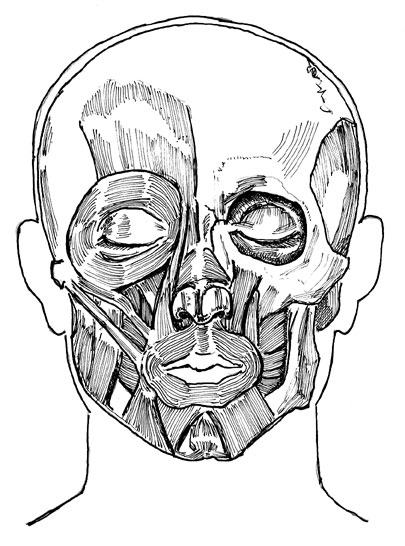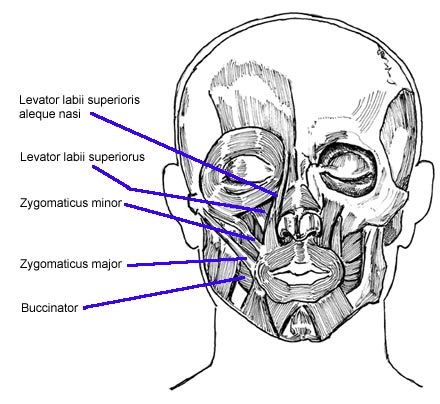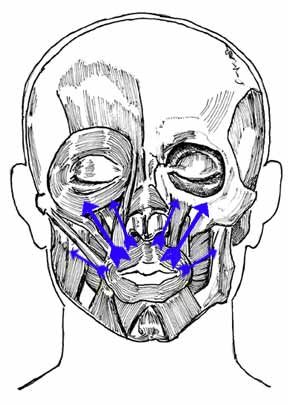Here's a picture of all the major facial muscles:
This is one of those stiff looking but strangely interesting anatomic illustrations. Facial musculature and facial expressions are pretty fascinating having roots you can follow all the way back to the days of the dinosaurs. Think of the facial muscles like this. Ever seen one of those modern double layer tents? Yes, tents - the kind you take you when you go camping. The kind where there's a base tent and then there's this wind guard layer that mirrors the main shape of the underlying main tent? It kind of floats over the "real" tent. Well that's how the facial muscles work: they more or less float over the underlying bones.
I don't want to be crude, but a person's face can literally be peeled off the skull surgically and then laid right back on it. (This is exactly what happens when you get a face lift.) It's attached almost as much by vacuum pressure as it is by any firm attachment (kind of like the way your contact lenses adhere to your eyes.)
The above picture points out the five main superficial muscles of the face that contribute most significantly to the formation of the cheeks, the nasolabial fold, and the overall shape of the apron of the upper lip.
Five main superficial muscles These five muscles exert the forces that form the cheeks
and lines around the mouth. The circular muscle around the mouth
(the orbicularis oris), is the main insertion point for the other five
muscles - the five labeled ones that is (I forgot to label the
"orbicularis oris" above - the muscle that circles the mouth and
lips. Well there, I just paid it lip service. Beat me, whip me). Here's
the orbicularis oris:
The origin for the five labeled facial muscles above is bone. Specifically the bone of the forehead and cheekbones. Now check this out. The cheekbone is called the "zygoma", and it just so happens the two muscles who's origins arise from the cheekbone are called respectively the "Zygomaticus major" and "Zygomaticus minor". Imagine that! Now doesn't that make it easier it remember? When a muscle contracts, the muscle shortens in the direction of it's origin. The insertion gets pulled towards the origin. The insertion point we're concerned about on our little tangent here is the insertion of these five muscles into the tissue and actual muscle around the mouth. All five of these muscles attach to that muscle and tissue. So, getting to the point, when you smile the overall tug on the mouth is up towards the nose and out towards the ears.
The direction of action of these five muscles What you don't see in these anatomic pictures are the fat, fascia, and skin that are the real contributors to the total, overall bulk of the cheeks. Fat or "subcutaneous tissue" and fascia (connective tissue), sit just below the skin and just above the muscle layers - fascia right on the muscle layers. In the upcoming muscle section, you'll be seeing mini-animations that demonstrate how each muscle works. For today's lesson, let this suffice. Go back and look at Hef's picture demonstrating the naso-labial fold with the "apron of the upper lip" in yellow. Click here to go straight back to it. Kasbohm & Company's YouCanDraw.com © Copyright, All rights reserved 1997 e-mail: jeffkaz@YouCanDraw
|



